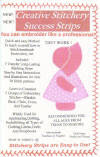Painted with Jo Sonja's Acrylic Gouache
 Beaded Dragonfly made for Tami's HGTV CQ RR Victorian block
Beaded Dragonfly made for Tami's HGTV CQ RR Victorian blockThe wings are made with clear iridescent dagger beads, the body is a cloisonne bead, and the tail is made from 6 iridescent oval beads.
This dragonly is made from the same materials as the one above, except the wings are iridescent turquoise dagger beads. The head is a clear iridescent glass bead and the eyes are tiny iridescent Delica beads.










 Illustration #1
Illustration #1  Illustration #2
Illustration #2 Illustration #3
Illustration #3 Illustration #4
Illustration #4 Illustration #5
Illustration #5  Illustration #6
Illustration #6 Illustration #7
Illustration #7 
 Illustration #9
Illustration #9  Illustration #10
Illustration #10































%2B(650x228).jpg)










